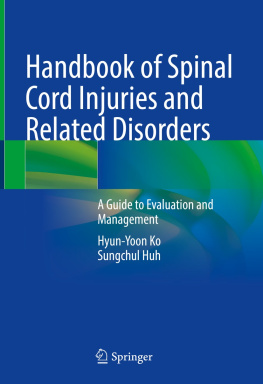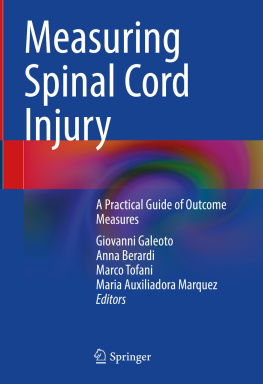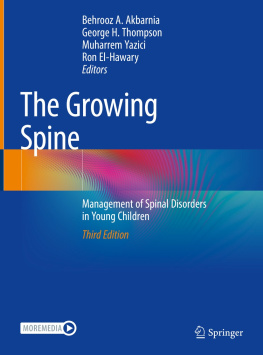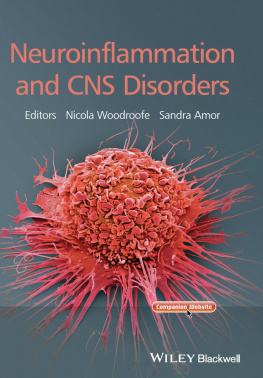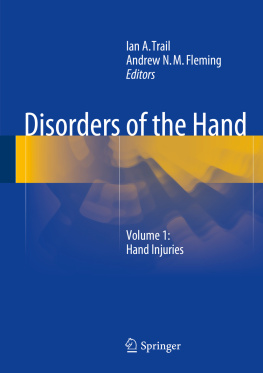Hyun-Yoon Ko and Sungchul Huh
Handbook of Spinal Cord Injuries and Related Disorders
A Guide to Evaluation and Management
1st ed. 2021

Logo of the publisher
Hyun-Yoon Ko
Department of Rehabilitation Medicine, Rehabilitation Hospital, Pusan National University Yangsan Hospital, Pusan National University College of Medicine, Yangsan, Korea (Republic of)
Sungchul Huh
Department of Rehabilitation Medicine, Rehabilitation Hospital, Pusan National University Yangsan Hospital, Yangsan, Korea (Republic of)
ISBN 978-981-16-3678-3 e-ISBN 978-981-16-3679-0
https://doi.org/10.1007/978-981-16-3679-0
The Editor(s) (if applicable) and The Author(s), under exclusive license to Springer Nature Singapore Pte Ltd. 2021
This work is subject to copyright. All rights are solely and exclusively licensed by the Publisher, whether the whole or part of the material is concerned, specifically the rights of translation, reprinting, reuse of illustrations, recitation, broadcasting, reproduction on microfilms or in any other physical way, and transmission or information storage and retrieval, electronic adaptation, computer software, or by similar or dissimilar methodology now known or hereafter developed.
The use of general descriptive names, registered names, trademarks, service marks, etc. in this publication does not imply, even in the absence of a specific statement, that such names are exempt from the relevant protective laws and regulations and therefore free for general use.
The publisher, the authors and the editors are safe to assume that the advice and information in this book are believed to be true and accurate at the date of publication. Neither the publisher nor the authors or the editors give a warranty, expressed or implied, with respect to the material contained herein or for any errors or omissions that may have been made. The publisher remains neutral with regard to jurisdictional claims in published maps and institutional affiliations.
This Springer imprint is published by the registered company Springer Nature Singapore Pte Ltd.
The registered company address is: 152 Beach Road, #21-01/04 Gateway East, Singapore 189721, Singapore
To my mother and to the memory of my father, who gave me everything and made me have a faithful mind.
To my mentors, who taught me with incredible generosity, shared their advanced knowledge, gave me opportunities to learn a lot from them, and inspire and motivate me.
To my special colleagues in the Department of Rehabilitation Medicine at Pusan National University College of Medicine for their passion and support.
To the most important person, my wife Insun, Dr. Park, for her understanding and support.
Hyun-Yoon Ko, MD, PhD
My greatest thanks go to all of my patients throughout the years with spinal cord injury.
To my wife, Sung Eun Lee, my little son, Junwoo Huh, and my parents for all their sacrifices for me and for teaching me the meaning of my life.
I greatly appreciate my teacher and mentor, Dr. Hyun-Yoon Ko, for taking the opportunity to participate in the writing.
Sungchul Huh, MD
Preface
Spinal cord medicine, which encompasses the diagnosis, treatment, and rehabilitation of patients with spinal cord injuries, has developed remarkably since World War II. Technology for the prevention and treatment of complications that cause death after spinal cord injuries such as cardiopulmonary and urinary complications and pressure injuries associated with spinal cord injuries has also been developed, and mortality and morbidity after the acute phase of spinal cord injury have become almost similar to that of people without spinal cord injury. In addition, it is good news that spinal cord injuries related to traffic accidents and accidents at work are on the decline. However, the lengthening of life expectancy after spinal cord injury over the past 20 years has been in a state of stagnation, and as the health age and lifespan of the general population increase overall, the difference in life expectancy between people with spinal cord injuries and the general population is gradually increasing.
Spinal cord injury is a very devastating event as it can directly or indirectly have negative effects on the person affected by spinal cord injury and their family and friends, including the urinary system, gastrointestinal system, sexuality, and psychosocial problems, as well as motor and sensory functions below the level of injury. Fortunately, however, most patients with spinal cord injuries can improve their quality of life and social participation through personal effort, rehabilitation, and medical assistance through spinal cord medicine. Successful rehabilitation after spinal cord injury can be achieved through a very comprehensive and well-planned effort by physicians and medical personnel involved in spinal cord medicine, physical therapists, occupational therapists, speech therapists, social workers, and psychologists. Despite significant advances in spinal cord medicine, physicians who are not involved in the treatment of patients with spinal cord injuries or who do not specialize in spinal cord medicine may not understand patients medically and may not provide proper primary care. Physicians or primary care providers have to make continuous efforts to be able to appropriately cope with medical situations and emergencies of people with spinal cord injuries.
Various medical problems of people with spinal cord injuries can be solved through a joint effort of internal medicine such as cardiology, respiratory medicine, infections, and endocrinology, neurology, orthopedic surgeon, neurosurgeon, urology, radiology, laboratory medicine, and physiatry. Therefore, physicians involved in spinal cord medicine must learn and acquire knowledge in a wide variety of fields such as functional anatomy, neuroanatomy, neurology, urology, orthopedics, and cardiopulmonary medicine, and strive to apply that knowledge appropriately. Medical infrastructure is required for the successful treatment and rehabilitation of patients with spinal cord injuries. Medical professionals practicing spinal cord medicine should endeavor to disseminate medical knowledge of spinal cord medicine and medico-social movement in order to achieve successful rehabilitation of our patients.
The knowledge of spinal cord medicine has been acquired from the knowledge of various fields mentioned above, and many kinds of specialized books related to spinal cord medicine are introduced. Some books were biased to deal with surgical issues, while others were quotes and descriptions from too many references, making it difficult to easily acquire knowledge about spinal cord injuries. The authors wrote this book with the intention of concisely presenting universal knowledge that can be applied clinically throughout the book, and as a book that can be easily referenced in the medical field. In addition, we have tried to keep up-to-date knowledge while dealing with various issues of spinal cord injury. Hopefully, if this book has an opportunity to lead to another edition in the future, it can make up for the lack of parts. The authors believe that this book can serve as a good reference as it can be easily read by physiatrists involved in the treatment of patients with spinal cord injuries, neurologists, urologists, internists, orthopedic surgeons, and neurosurgeons in the medical field of spinal cord medicine.

